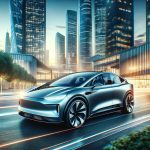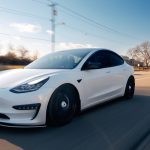The automotive industry buzzed with speculation following a report suggesting Tesla had discontinued plans for a budget-friendly electric vehicle. Elon Musk, the CEO of Tesla, quickly countered the claims, declaring outright that the report was false. This swift response highlights the ongoing intrigue surrounding Tesla’s ambitious projects, including affordable cars and autonomous robotaxis. As Tesla’s next-generation vehicles loom on the horizon, the intertwining paths of affordable electric transportation and self-driving technology continue to captivate investors and consumers alike.
Historical reports have long scrutinized the electric vehicle (EV) market, with Tesla often at the epicenter of attention. The anticipated arrival of a cost-effective Tesla model, priced near $25,000, was seen as a potential catalyst for widespread EV adoption. Tesla has always positioned itself as a pioneer in the EV space, consistently pushing boundaries in innovation and market expansion. Previous discussions about Tesla’s EV lineup suggested an alignment of interests in creating affordable, mass-market vehicles while advancing self-driving capabilities. This duality of intent reaffirmed the company’s commitment to enhancing accessibility to clean transportation and pioneering autonomous driving technology.
Musk’s Prompt Dismissal of Claims
Elon Musk took to social media to vehemently deny assertions by a leading news publication that Tesla had halted its affordable EV initiative. Musk’s reputation for candid communication with the public and stakeholders routinely involves correcting what he views as misinformation. This exchange is the latest in a series of public refutations by Musk concerning Tesla’s strategic moves.
Tesla’s Dual Focus: Affordable Cars and Robotaxis
Despite the claims of program cancellation, it’s generally understood that Tesla has been working on both an affordable EV and a dedicated robotaxi platform. The two vehicles were expected to share a common platform, differing primarily in their human interface components. This approach suggested that Tesla’s investment in self-driving technology wouldn’t detract from its commitment to producing more financially accessible EVs.
The Ongoing Debate Over Tesla’s Strategies
The debate on Tesla’s strategic direction extends beyond the contested report. In a nod to Tesla enthusiasts, Musk posted a cryptic “eyes” emoji on social media, signaling potential shifts in resource allocation favoring fully self-driving (FSD) technology and dedicated robotaxis. This ambiguity reflects Tesla’s agility in navigating the fast-evolving terrain of EV and autonomous driving technologies.
In a broader context, similar news stories have fostered discussions surrounding Tesla’s global ambitions and competitive strategies. A piece titled “Tesla’s Next-Gen Vehicle Platform Raises Industry Expectations” from CleanTechnica delved into the potential implications of Tesla’s platform strategy on automotive manufacturing paradigms. Meanwhile, Electrek’s “Tesla’s Market Maneuvering: Insights on Strategic Positioning” analyzed the company’s positioning in the global market amidst growing competition. Both articles offered perspectives that enrich the ongoing discourse on Tesla’s trajectory in the EV landscape.
Helpful Points
- Musk denies the alleged discontinuation of Tesla’s affordable EV.
- Shared platforms may underlie both affordable EVs and robotaxis.
- Public statements by Musk often address and correct media reports.
Elon Musk’s counter to the claim of scrapping Tesla’s affordable car underscores the dynamic interplay between company strategy and public perception. This incident highlights the significance of transparent communication in mitigating misinformation. It also reaffirms Tesla’s commitment to democratizing electric mobility while advancing autonomous driving technology. As Tesla navigates this complex landscape, the company’s actions continue to have far-reaching implications for the industry’s future.










